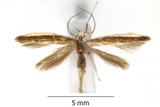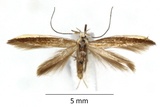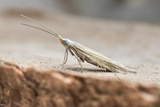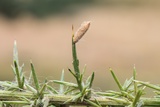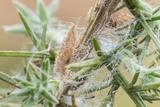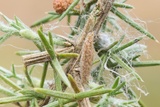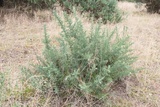Coleophora albicosta (Haworth, 1828) Species
Last modified: June 5, 2025, 2:47 p.m.
A very rare and local species in Belgium that has been found in more places since 2004. Nevertheless it remains rarely observed.
Details
- Classification
- Family: Coleophoridae > Genus: Coleophora > Species: Coleophora albicosta
- Vernacular names
- Gaspeldoornkokermot (NL), Gorse case-bearer (EN), Stechginster-Sackmotte (DE)
- First mention in Belgium
- Fologne E. 1863. Addenda au catalogue des Lépidoptères de Belgique. — Annales de la Société entomologique belge 7: 87–93. On page 92 (as Coleophora Albicosta Hw.). view page
- Status
-
Native
Distribution
Case
The fully developed case is ± 7 mm long, tri-valved and with a mouth angle of 45°–60°.
See also bladmineerders.be.
Bionomics
The larva bores into a seed pod of Ulex europaeus or Genista spp. and feeds on the developing seeds. Later it leaves the pod and constructs a cigar-shaped case made of sepals. Finally, it leaves its feeding case and spins another case entirely made of silk.
The larva pupates after overwintering.
The adults are day-active, especially at dusk and later on come infrequently to light.
Flight periods
The adults fly from late May till early July in one generation.
Observed on
- Host plant (species):
- Ulex europaeus and Genista germanica
- Host plant (genera):
- Ulex and Genista
The main hostplant is Ulex europaeus.
